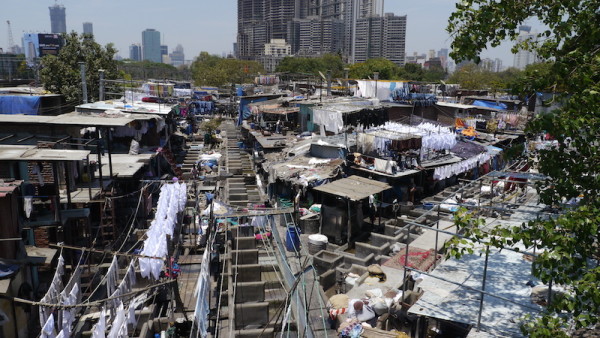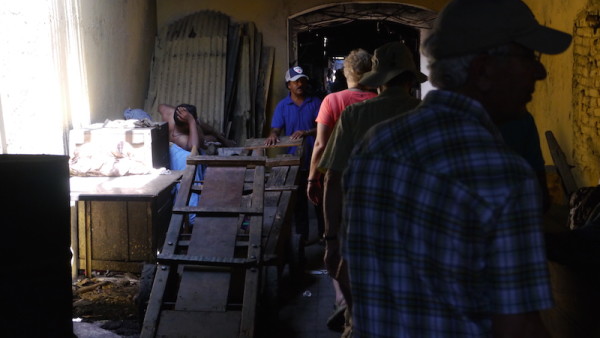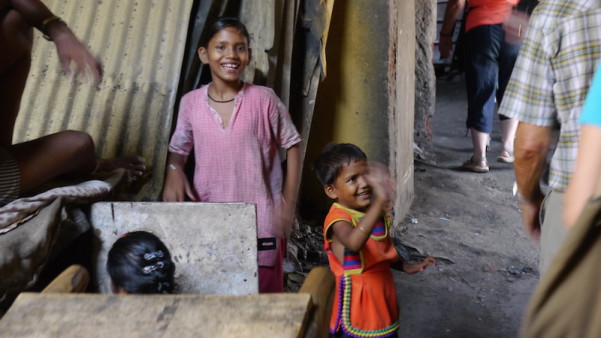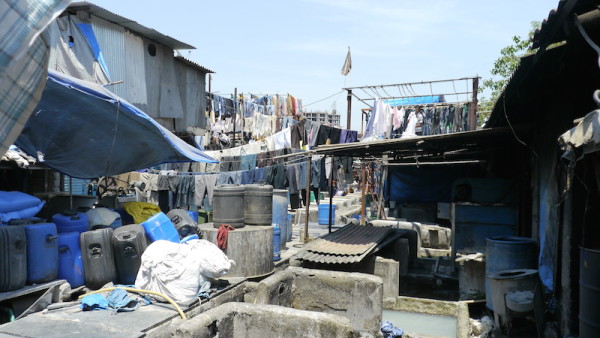 I’ll never wash clothes again without recalling this place. If you know Mumbai (Bombay), you’ve guessed what I’m about to describe.
I’ll never wash clothes again without recalling this place. If you know Mumbai (Bombay), you’ve guessed what I’m about to describe.
Dhobi ghat. It’s the central laundry district founded in 1890 that sits smack dab in the middle of the city. Yesterday, as part of a lengthy private tour shared with four other guests, we visited dhobi ghat. Tourist groups tend to stand on an observation deck where they oversee the vast area, but we walked down treacherous steps into the actual operation. Led by a “guide” who mumbled explanations, we wove our way for a long time through the steamy, confusing alleys.
 Alleys? I hesitate to call them that, because they were more like crumbling spaces between open concrete tubs, rusted tin lean-to’s, and crooked stretches of drying clothes. The action of washing as many as one million pieces of laundry a day is accomplished by more than 700 ghobis, people from the lower caste of India’s society who have held this job for generations.
Alleys? I hesitate to call them that, because they were more like crumbling spaces between open concrete tubs, rusted tin lean-to’s, and crooked stretches of drying clothes. The action of washing as many as one million pieces of laundry a day is accomplished by more than 700 ghobis, people from the lower caste of India’s society who have held this job for generations.
The area occupies a carved out space below street level. If you look up, you see glittering sky-scrapers and busy traffic. If you look down, you see stretches of blue jeans, hospital sheets, flapping saris, and workmen’s uniforms, hung not with clips, but woven into the strands of the clotheslines. Large open stone tubs are filled with water—some clear, some blue, and some murky. Men of every age (including boys) weave in and out of these tubs. Some men tinier than I am carry inordinately enormous bundles on their backs, filled with heavy wet sheets or rugs. Other men are ironing in dark crevices, pushing bulky charcoal-powered irons with barely a ray of sunlight to guide the way.
Here and there we saw monstrous electronic washers or even some cylindrical driers that were clearly used for some items. They may have been state-of-the-art but they seemed rickety and groaning under the burden placed on them. Mostly the clothes were hung to dry . . . in Mumbai’s humid tropical air. What happens during the monsoons, I wondered, when the rains saturate the city for weeks?
 Kids are everywhere, some squatting near momma as she sorts or mends, others seeming to help, while the tiniest were playing in the dark crevices. It was hard to photograph (although we were allowed), first because most of it is dark. Dark, wet, and slippery. The smell of water, soap, and sweat is intense. It’s also hard to photograph since one feels exploitative aiming a camera at people who are engaged in this kind of back-breaking work. There aren’t options for them. These are the “untouchables,” at least as we understood. Whoever is born into this trade has a hard time breaking out.
Kids are everywhere, some squatting near momma as she sorts or mends, others seeming to help, while the tiniest were playing in the dark crevices. It was hard to photograph (although we were allowed), first because most of it is dark. Dark, wet, and slippery. The smell of water, soap, and sweat is intense. It’s also hard to photograph since one feels exploitative aiming a camera at people who are engaged in this kind of back-breaking work. There aren’t options for them. These are the “untouchables,” at least as we understood. Whoever is born into this trade has a hard time breaking out.
Yet at one moment, a dilapidated door in one of these cave-like structures swung open to the back cubicle. For just a second, I saw two men seated in front of a bright, modern computer monitor. They were on-line, doing whatever it was. Were they organizing the laundry orders on-line? Could it be that, while the actual work resembled slavery from Ancient times, the orders themselves are coordinated on Excel?
Or, perhaps since it was nearing the end of lunchtime, these men were using their few minutes of free time reading whatever caught their interest. Video games, maybe? I have no idea.
 But I was stunned to see the blending of the fully modern world with the oppressive physical labor in front of our eyes. No contrast I saw in the places we traveled here in India struck me more. And, believe me, we had driven into some remote, and startling, areas.
But I was stunned to see the blending of the fully modern world with the oppressive physical labor in front of our eyes. No contrast I saw in the places we traveled here in India struck me more. And, believe me, we had driven into some remote, and startling, areas.
I have to go home and read about this. I want to know how dhobi ghat fits into a modern civilization of 21 million—a society graced by towering Victorian architecture, glassy skyscrapers, and a robust technology market. The poverty of Mumbai overall seemed much less than what we’d experienced elsewhere in India, and that’s true, statistically. But dhobi ghat was a throw-back to feudal times, where the caste system reigned and the wages were but pennies an hour.
And it’s also how a lot of people get their laundry done at a reasonable price, we were told. I confess I don’t understand the system. Back in our van, our educated guide said, yes it was controversial but also a great tourist attraction from up on the roadside platform. Still, there was a lot of public discussion about “what to do.”
I have no idea. Is it an ancient heritage? A cultural treasure not to be disturbed (even if lives are drained away in its service)? Or is it an embarrassing remnant of a period when slavery and child labor were the norm? The same question, the same dilemma has struck me multiple times in India. But dhobi ghat presented the most intense picture so far of this enigma called India.



